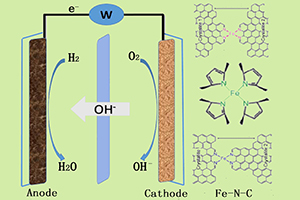

Fe-N-C 类催化剂在碱性燃料电池中的研究进展
收稿日期: 2017-12-13
修回日期: 2018-01-05
网络出版日期: 2018-01-22
基金资助
国家自然科学基金项目(No. 21676241,No. U1732111)
Recent Progress for Fe-N-C Electrocatalysts in Alkaline Fuel Cells
Received date: 2017-12-13
Revised date: 2018-01-05
Online published: 2018-01-22
Supported by
National Natural Science Fundation of China(No. 21676241,No. U1732111)资助

邓 昕 , 陈亨权 , 胡 野 , 和庆钢 . Fe-N-C 类催化剂在碱性燃料电池中的研究进展[J]. 电化学, 2018 , 24(3) : 235 -245 . DOI: 10.13208/j.electrochem.171213
Fuel cells are highly recommended nowadays due to their intrinsic advantages such as high energy conversion efficiency, nearly no pollution, and convenient operation. With the development of anion exchange membrane, alkaline fuel cells have gone through a renaissance thanks to their superiorities such as faster reaction kinetics, wider choices for both fuels and electrocatalysts. It is essential to find an appropriate electrocatalyst for oxygen reduction reaction (ORR) to improve the performance of alkaline fuel cells. Further commercialization of the widely used Pt-based materials has suffered from disadvantages such as scarcity and high cost. As alternatives to largely investigated Pt-based materials, Fe-N-C electrocatalysts have gained increasing attention. However, Fe-N-C electrocatalysts still face problems including imperfect stability and durability, low metal loading, unclear catalytic mechanism and active sites, which has further hindered their design and synthesis. In this review, Fe-N-C electrocatalysts for alkaline fuel cells are discussed from the following three aspects, namely, the synthesis methods, the active sites and mechanisms, and their applications in recent five years. To optimize synthetic conditions, two kinds of typical synthetic methods are overviewed and some synthetic examples in the recent five years are summarized. Three active sites such as FeN4/C, Fe-N2+2/C, and Fe-N2/C, as well as those active sites concerned more widely in recent research for Fe-N-C electrocatalysts are also reviewed, which lays a good foundation for future design of Fe-N-C electrocatalysts. Furthermore, the single cell performance data are provided for the first time in order to enhance the application of the Fe-N-C electrocatalysts in alkaline fuel cells. As a whole, this review aims at providing theoretical support and guidance for future design and synthesis of commercial Fe-N-C electrocatalysts.

Key words: fuel cells; oxygen reduction reaction; Fe-N-C; electrocatalysts
/
| 〈 |
|
〉 |